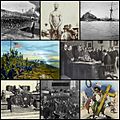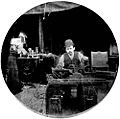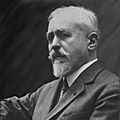1890s facts for kids
The 1890s were a very exciting time, full of big changes and new inventions! This decade, from 1890 to 1899, saw many important events around the world. People were inventing new things like early cars and motion pictures. There were also major economic changes and important political events that shaped the future.
| Millennium: | 2nd millennium |
| Centuries: | 18th century – 19th century – 20th century |
| Decades: | 1860s 1870s 1880s – 1890s – 1900s 1910s 1920s |
| Years: | 1890 1891 1892 1893 1894 1895 1896 1897 1898 1899 |
| Categories: | Births – Deaths – Architecture Establishments – Disestablishments |
Contents
Important Events of the 1890s
The 1890s were a time of big changes and challenges. Here are some key events that happened:
Workers' Rights and Economic Challenges
- In 1892, workers at a steel plant in the United States went on strike. This event, known as the Homestead strike, showed the struggles between workers and large companies.
- The Panic of 1893 caused a big economic downturn. This period of financial trouble lasted for most of the 1890s, affecting many people.
Civil Rights and Segregation
- In 1896, a very important court case called Plessy v. Ferguson happened. This ruling allowed for racial segregation, meaning that Black and white people could be kept separate in public places. This led to unfair Jim Crow laws that lasted for many years.
New Technologies and Inventions
- The 1890s were a time of amazing inventions! Thomas Edison invented the kinetograph, which was an early machine for making motion pictures. This was a huge step towards the movies we watch today.
- Cars were also developing quickly. The 1895 Benz Velo and the Duryea Motor Wagon were some of the first standardized cars. This decade saw many improvements in how cars were made.
Wars and Global Changes
- In 1898, the USS Maine ship sank in Havana Harbor. This event helped start the Spanish–American War.
- During the Spanish–American War, U.S. Marines helped in the land battles in Cuba.
- After the war, the U.S. paid $20 million to Spain to get the Philippines in the Treaty of Paris.
Other Interesting Events
- The World's Columbian Exposition was a huge world's fair held in Chicago in 1893. It showed off new technologies and cultures from around the globe.
- Many people went to the Klondike gold rush in the late 1890s, hoping to find gold. This led to many new mining towns.
Famous People Born in the 1890s
Many famous people who changed the world were born in this decade:
- May 19, 1890 – Ho Chi Minh: He became a very important leader in Vietnam.
- September 15, 1890 – Agatha Christie: A famous English writer known for her mystery novels.
- October 2, 1890 – Groucho Marx: A well-known American comedian and actor.
- October 14, 1890 – Dwight D. Eisenhower: He later became the president of the United States.
- November 22, 1890 – Charles de Gaulle: A future president of France.
- June 9, 1891 – Cole Porter: A talented American musician and composer.
- January 3, 1892 – J.R.R. Tolkien: The famous English author who wrote The Hobbit and The Lord of the Rings.
- May 7, 1892 – Josip Broz Tito: He became a significant leader in Yugoslavia.
- December 26, 1893 – Mao Zedong: A very important leader in China.
World Leaders of the 1890s
Many powerful leaders were in charge during the 1890s:
Leaders in North America
- In Canada: Prime Minister John Sparrow David Thompson and Prime Minister Sir Wilfrid Laurier.
- In the United States: Presidents Benjamin Harrison, Grover Cleveland, and William McKinley.
Leaders in Europe
- In Austria-Hungary: Emperor Franz Josef.
- In the German Empire: Kaiser Wilhelm II and Chancellor Leo von Caprivi.
- In Italy: King Umberto I.
- The head of the Catholic Church was Pope Leo XIII.
- In Russia: Czar Alexander III and Czar Nicholas II.
- In the United Kingdom of Great Britain and Ireland: Queen Victoria was the monarch. Prime Ministers included Robert Arthur Talbot Gascoyne-Cecil, 3rd Marquess of Salisbury, William Ewart Gladstone, and Archibald Philip Primrose, 5th Earl of Rosebery.
Leaders in Asia
- In Persia (under the Qajar dynasty): Nasser-al-Din Shah (until 1896) and then Mozzafar-al-Din Shah (from 1896).
Images for kids
-
From left, clockwise: Union workers at a Carnegie Steel plant go on a strike later known as the Homestead strike in 1892; Plessy v. Ferguson establishes the doctrine of racial segregation and leads to Jim Crow laws; USS Maine sinks in Havana Harbor in 1898 sparking the Spanish–American War; U.S. pays $20 million to get the Philippines from Spain in the Treaty of Paris; a cartoon mocks the Cross of Gold speech given by William Jennings Bryan who argues against the gold standard; Panic of 1893 instigates an economic depression which lasts for most of the 1890s; Thomas Edison invents the kinetograph, an early example of motion-picture technology; US Marines hoist a US flag during the land campaign of Cuba in the Spanish–American War.
-
A typical gold mining operation, on Bonanza Creek.
-
1895 Benz Velo. Along with its contemporary Duryea Motor Wagon, those vehicles were considered the earliest standardized cars. The 1890s also saw further developments in the history of the automobile.
See also
 In Spanish: Años 1890 para niños
In Spanish: Años 1890 para niños



















